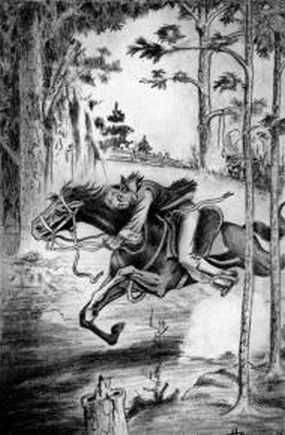Loyalist sentiment in North Carolina largely moved into the shadows in the aftermath of Moores Creek Bridge. In the summer of 1780 a second uprising was crushed at Ramsour's Mill in present-day Lincolnton. North Carolina Tories did not present a threat to the Whig government again until the spring of 1781. As Cornwallis's army marched through the Piedmont and into the eastern part of the state, Loyalists in Randolph, Chatham and Orange Counties organized under a charismatic 26-year-old former Patriot named David Fanning.
Originally from Virginia, Fanning had lived in both North Carolina and South Carolina, and had served in both Loyalist and Whig militias before organizing Loyalists in Chatham County in February 1781. He established a fortified base at Cox's Mill on the Deep River in Randolph County from which he recruited Tories, skirmished with Whig militia, and scouted for Cornwallis's army. In July 1781, Fanning received a commission as a provincial colonel in command of all Loyalist forces in Randolph, Chatham, Orange, Cumberland, and Anson Counties.
From July until December 1781, as both American and British regular troops left the area, Fanning's Loyalist militia terrorized central North Carolina. Shortly after receiving his commission, Fanning led a brazen daylight raid on the Chatham County Courthouse, interrupting a trial of several Loyalists (thereby saving their lives) and capturing nearly every local Whig politician and military leader. The following month Fanning attacked the home of Philip Alston (today known as House in the Horseshoe) and then joined forces with Colonel Hector McNeil's Bladen County Loyalist militia. Together they defeated Patriot militia led by Colonel Thomas Wade at McPhaul's Mill on September 1.
Eleven days after McPhaul's Mill, Fanning led his most daring exploit of the war. With nearly 900 Loyalists under his command, Fanning raided the temporary state capital at Hillsborough, capturing nearly 200 Whigs including Governor Thomas Burke. The following day Whig militia led by Brigadier General John Butler intercepted Fanning at Lindley's Mill. In a four-hour battle, Hector McNeil was killed and Fanning severely wounded, but the Loyalists managed to drive the Whigs from the field.
After delivering his prisoners to British authorities in Wilmington, Fanning attempted to remain in the field. However, the British evacuation of the port city in November 1781 removed his source of supplies and ammunition. In January 1782 Fanning began negotiations with North Carolina authorities for a pardon that he would never receive. In April, Fanning fled to Charleston and, by the close of the war, had settled in New Brunswick, Canada. Convicted of rape in 1801, Fanning was sentenced to death but successfully appealed to the provincial governor and received a pardon. Ordered to leave the province, Fanning moved to Nova Scotia where he became a shipbuilder and died peacefully in 1825.
